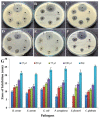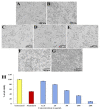Isolation, Characterization of Pyraclostrobin Derived from Soil Actinomycete Streptomyces sp. HSN-01 and Its Antimicrobial and Anticancer Activity
- PMID: 37508307
- PMCID: PMC10376734
- DOI: 10.3390/antibiotics12071211
Isolation, Characterization of Pyraclostrobin Derived from Soil Actinomycete Streptomyces sp. HSN-01 and Its Antimicrobial and Anticancer Activity
Abstract
The present study demonstrated the isolation, characterization, and antimicrobial and anticancer activity of active metabolite produced from mining-soil-derived actinomycetes. Among the 21 actinomycete isolates, the isolate HSN-01 exhibited significant antimicrobial activity in primary screening and was identified as Streptomyces sp. through 16S rRNA gene sequencing. The active metabolite was separated, purified, and confirmed through UV-Vis spectroscopy, FTIR, HR-ESI-MS, and NMR analysis and identified as pyraclostrobin. Further, the active metabolite pyraclostrobin was tested for antimicrobial and anticancer activity against the hepatocellular carcinoma (HepG2) cell line. The metabolite exhibited maximum antimicrobial potential with 17.0, 13.33, 17.66, 15.66, 14.66, and 14.0 mm of inhibition against B. cereus, S. aureus, E. coli, P. aeruginosa, S. flexneri, and C. glabrata. The active metabolite exhibited dose-dependent anticancer potential against the hepatocellular carcinoma (HepG2) cell line with the IC50 56.76 µg/mL. This study suggests that Streptomyces sp. HSN-01 is an excellent source of active secondary metabolites with various biological activities.
Keywords: NMR; Streptomyces sp.; anticancer activity; antimicrobial activity; pyraclostrobin.
Conflict of interest statement
The authors declare no conflict of interest.
Figures











References
-
- Niazi S.K., Basavarajappa D.S., Kumaraswamy S.H., Bepari A., Hiremath H., Nagaraja S.K., Rudrappa M., Hugar A., Cordero M.A.W., Nayaka S. GC-MS Based characterization, antibacterial, antifungal and anti-oncogenic activity of ethyl acetate extract of Aspergillus niger strain AK-6 isolated from rhizospheric soil. Curr. Issues Mol. Biol. 2023;45:3733–3756. doi: 10.3390/cimb45050241. - DOI - PMC - PubMed
-
- Shashiraj K.N., Nayaka S., Kumar R.S., Kantli G.B., Basavarajappa D.S., Gunagambhire P.V., Almansour A.I., Perumal K. Rotheca serrata flower bud extract mediated bio-friendly preparation of silver nanoparticles: Their characterizations, anticancer, and apoptosis inducing ability against pancreatic ductal adenocarcinoma cell line. Processes. 2023;11:893. doi: 10.3390/pr11030893. - DOI
-
- Rammali S., Hilali L., Dari K., Bencharki B., Rahim A., Timinouni M., Gaboune F., El Aalaoui M., Khattabi A. Antimicrobial and antioxidant activities of Streptomyces species from soils of three different cold sites in the fez-meknes region Morocco. Sci. Rep. 2022;12:17233. doi: 10.1038/s41598-022-21644-z. - DOI - PMC - PubMed
-
- Chanthasena P., Hua Y., Rosyidah A., Pathom-Aree W., Limphirat W., Nantapong N. Isolation and identification of bioactive compounds from Streptomyces actinomycinicus PJ85 and their in vitro antimicrobial activities against methicillin-resistant Staphylococcus aureus. Antibiotics. 2022;11:1797. doi: 10.3390/antibiotics11121797. - DOI - PMC - PubMed
Grants and funding
LinkOut - more resources
Full Text Sources
Miscellaneous

